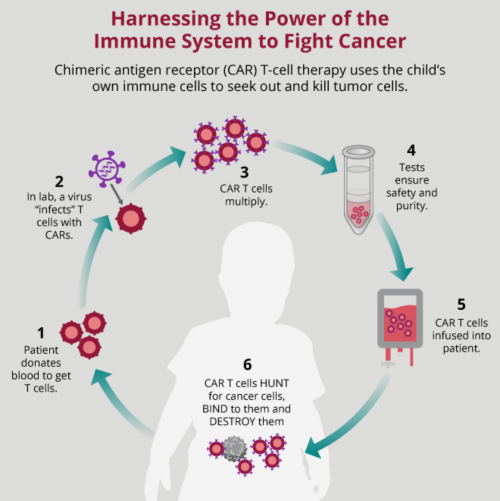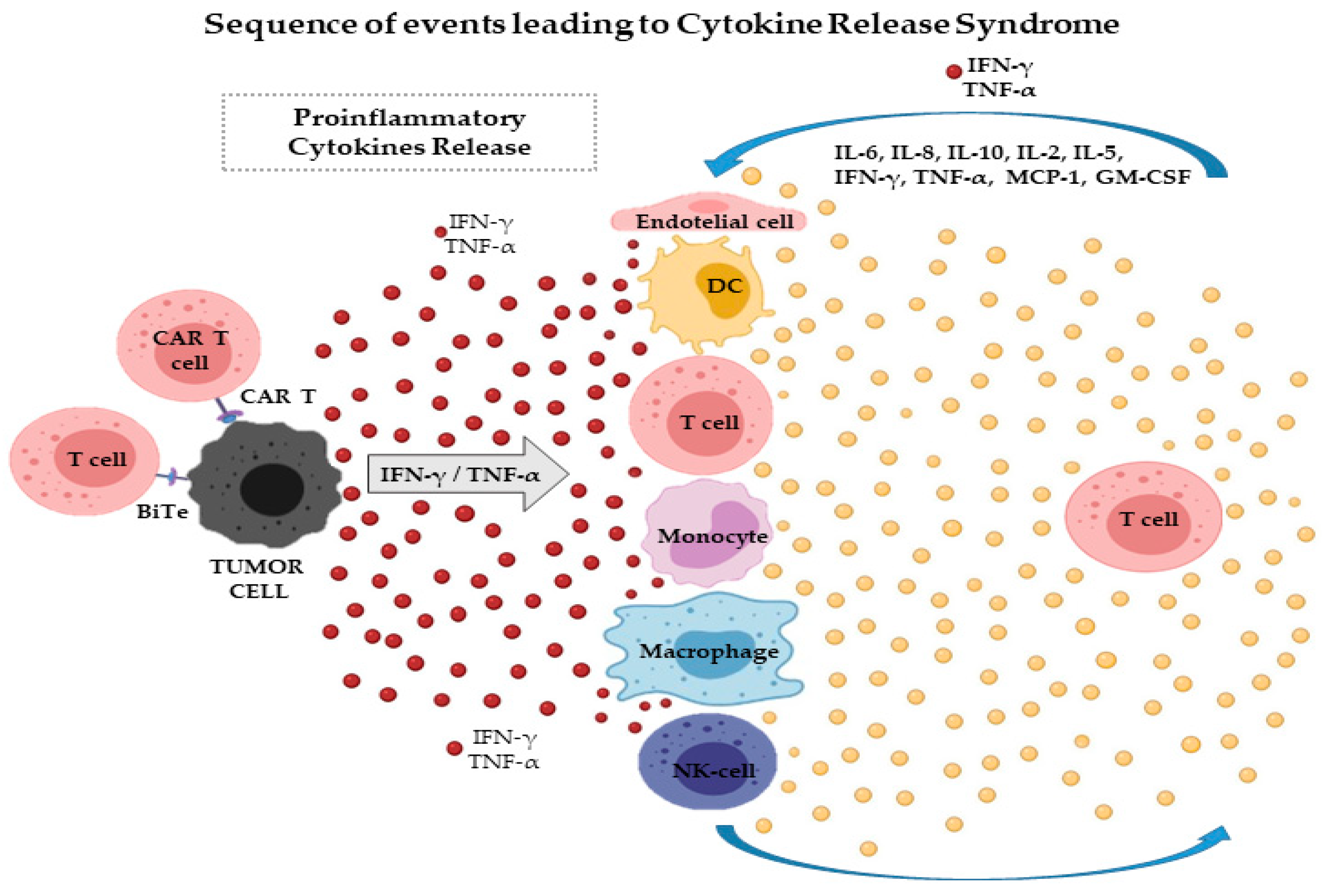What Best Describes Cytokine Release Syndrome Crs
Fever hypotension tachycardia hypoxia and chills. Cytokine release syndrome CRS is a potentially life-threatening systemic inflammatory response observed following administration of antibodies and adoptive T cell therapy.

Cytokine Release Syndrome Crs After Immunotherapy Together
CRS may be associated with cardiac hepatic andor renal dysfunction.

. On the current evidence we give practical guidance to the management of the cytokine release syndrome. It refers to cytokine storm syndromes CSS and occurs when large numbers of white blood cells are activated and release inflammatory cytokines which in turn activate yet more white blood cells. TriTAC-XR our third such platform is designed to minimize on-target cytokine release syndrome CRS a characteristic of many T.
Synovial sarcoma SS ovarian cancer OC. Cytokine release syndrome is a form of systemic inflammatory response syndrome that can be triggered by a variety of factors such as infections and certain drugs. CRS has been described after the infusion of several antibody-based therapies including rituximab 10 11 obinutuzumab 12 alemtuzumab 13 brentuximab 14.
Cytokine release syndrome CRS is a systemic inflammatory response that can be triggered by a variety of factors such as infection and certain medications including monoclonal antibodies. Cytokine release syndrome CRS is observed with adoptive T-cell therapies ACT with varying frequency. Harpoon is committed to developing best-in-class T cell engagers.
3 4 CRS is a systemic inflammatory response that occurs following an extensive release of inflammatory cytokines secondary to the activation of myeloid cells and lymphocytes and is mainly characterized by rash fever mental status changes etc which is more apparent in patients. Immune effector cell-associated neurotoxicity syndrome ICANS is a. Cytokines are small proteins that act as cell messengers.
However the immune activation responsible for high remission rates is also responsible for the unique treatment-related toxicity of cytokine release syndrome CRS. Atrial fibrillation and ventricular tachycardia. Immune activation is the mainstay of this therapy and as such there has been an associated increase in a wide array of systemic proinflammatory cytokines such as IL-6.
Cytokine release syndrome CRS is a potentially life-threatening systemic inflammatory response observed following administration of antibodies and. Harpoon is committed to developing best-in-class T cell engagers. Cytokine-release syndrome is a symptom complex associated with the use of many monoclonal antibodies.
Cytokine release syndrome CRS is an acute systemic inflammatory syndrome characterized by fever and multiple organ dysfunction that is associated with chimeric antigen receptor CAR-T cell therapy therapeutic antibodies and haploidentical allogeneic transplantation. Cytokine Release Syndrome CRS. It is also referred as infusion reaction that results in release of large amount cytokines Like IL-6 IFN-r INF from the target cells.
CRS is also an. Commonly referred to as an infusion reaction it results from the release of cytokines from cells targeted by the antibody as well as immune effector cells recruited to the area. Cytokine Release Syndrome Market.
DelveInsights Cytokine Release Syndrome Market Insights Epidemiology and Market Forecast-2032 report delivers an in-depth understanding of the Cytokine Release Syndrome historical and forecasted epidemiology as well as the Cytokine Release Syndrome market trends in the United States EU5 Germany Spain Italy France and. 7-8 days Manifestation may include. What Is Cytokine Release Syndrome.
Cytokine release syndrome CRS is a potentially life-threatening toxicity that has been observed following administration of natural and bispecific antibodies or following adoptive T-cell therapies in different oncological conditions. When cytokines are released into the circulation systemic symptoms such as fever nausea chills. These new treatments are associated with rare toxicities such as cytokine release syndrome CRS defined by fever tachypnea headache tachycardia hypotension skin rash andor hypoxia.
The syndrome occurs when immune cells are activated and release large amounts of cytokines into the body. Cytokine release syndrome Immunotherapy CAR T cells T cell-engaging therapies Cytokine storm Background Cytokine release syndrome CRS is a systemic inflam-matory response that can be triggered by a variety of fac-tors such as infections and certain. Cytokine Release Syndrome The most common toxicity associated with CAR T-cell treatment is cytokine release syndrome CRS a systemic inflammatory response that can lead to reversible organ dysfunction and neurologic toxicity.
Recognize Symptoms Early Typical onset. CRS prevalence and severity within the context NY-ESO-1 C259 T across 5 studies in 4 tumor types were examined. Serious events may include.
Cytokine release syndrome CRS is a life threatening toxicity associated numerous immunotherapeutic techniques involving monoclonal antibodies bispecific antibodies and adoptive T cell therapies. Immune activation is the mainstay of this therapy and as such there has been an associated increase in a wide array of systemic proinflammatory cytokines such as IL-6. Cytokine release syndrome CRS is a potentially life-threatening systemic inflammatory response observed following administration of antibodies and adoptive T cell therapy.
CRS was defined by the ASTCT consensus group as a supraphysiologic response following any. Describe cytokine release syndrome CRS and neurotoxicity associated with CAR T-cell administration Identify currently approved CAR T-cell products and their place in therapy Identify appropriate treatment strategies for CRS and neurotoxicity Nurse Describe cytokine release syndrome CRS and neurotoxicity associated with CAR T-cell administration. In June 2018 in an effort to standardize CRS grading the American Society for Transplantation and Cellular Therapy ASTCT developed the ASTCT Consensus Grading for Cytokine Release Syndrome and Neurologic Toxicity Associated with Immune Effector Cells Tables 2 4.
TriTAC-XR our third such platform is designed to minimize on-target cytokine release syndrome CRS a characteristic of many T. Starting as a fever it can rapidly progress to hypotension hypoxia and end-organ dysfunction. 2-3 days Typical duration.
CRS can be life threatening and may require steroids which hinder the effectiveness of ACT. The clinical signs of CRS include fever hemodynamic instability and capillary leak which correlate with T-cell activation and elevated cytokine levels. An important side effect of rituximab is cytokine release syndrome CRS.
Cytokine release syndrome CRS is a collection of symptoms that can develop as a side effect of certain types of immunotherapy especially those which involve T-cells. The physiopathology of CRS is caused by the release of effector cytokines IFNγ TNFα Interleukin 2 which are responsible for activating monocytes and macrophages. Cytokine release syndrome CRS or cytokine storm is an acute inflammatory syndrome caused by the activation of immune cells and release of proinflammatory cytokines.

Ijms Free Full Text Cytokine Release Syndrome Associated With T Cell Based Therapies For Hematological Malignancies Pathophysiology Clinical Presentation And Treatment Html

Comments
Post a Comment